Students should conduct research and utilize the information in the "Strategic Sourcing and Supply at Federal Express" case study to complete the following assignment tasks. Complete a SWOT analysis
Strategic Sourcing and Supply at Federal Express1
Background – Federal Express
FedEx Corporation is a $20 billion market leader in transportation, information, and logistics solutions, providing strategic direction to the five main operating companies. These include:
FedEx Express: The world's largest express transportation company. Leveraging its unmatched air route authorities and extensive air/ground infrastructure, FedEx Express connects markets, within just 1 to 2 business days that comprise 90% of the world's economic activity.
FedEx Ground: North America's second-largest ground carrier for business-to-business small-package delivery. Provider of innovative new residential delivery service – FedEx® Home Delivery – in key U.S. cities and a pioneer in applying advanced information technology to meet customer needs
FedEx Freight: A $1.9 billion leading provider of next-day and second-day regional LTL freight services. FedEx Freight is comprised of two independent yet complementary operating companies, American Freightways and Viking Freight, known for exceptional service, reliability and on-time performance.
FedEx Customer Critical: North America's largest time-specific, critical-shipment carrier provides exclusive-use, non-stop, door-to-door delivery throughout the U.S. and Canada and within Europe – 24 hours a day, 365 days a year.
FedEx Trade Networks: A full-service customs brokerage, trade consulting, and e-clearance solutions organization designed to speed shipments through customs using advanced e-commerce programs.
FedEx Services: Provides customer access to the full range of FedEx transportation, logistics, e-commerce and information services by integrating sales, marketing and information technology
FedEx Center-Led Initiative
Prior to the purchase of the Ground, Freight, and other non-express based services, Federal Express had re-organized all of its major indirect spend in information technology, aircraft, facilities/business services, vehicles/fuel/ground service equipment, and supply chain logistics groups under the “Strategic Sourcing and Supply” group, led by Edith Kelly-Green. After the purchase of these different businesses occurred, the supply management function was re-organized into a Center-led Supply Chain Management sourcing model. Over the last two years, FedEx Supply Chain Management has been focusing on leveraging sourcing and contracting for all of the Fedex family of companies. For office supplies, instead of having each company run a contract, SCM has a single corporate contract for all of the negotiation effort, but allowing for different transactional approaches. It has been a gradual migration to getting to a centralized view to how procurement will happen. It is central for the larger spend areas, and different policy requirements.
A big component of this model is the integration of Ariba Buyer – expanding the use of it to other operating companies, and processing requisitions within the SCM group. Most of the best practices discussed in this case are associated with FedEx Express, but is slowly being migrated across all of the operating companies.
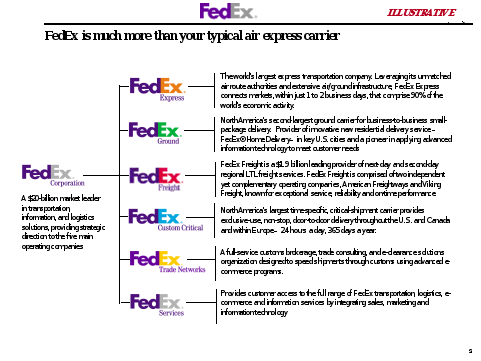
The Sourcing Process
FedEx established a seven step sourcing process.
Step 1: First step is an assessment of the category that profiles that industry and commodity. The team will ensure that they are clear on the user requirements from the corporation, and try to define what that category amounts to. For example, on promotional items – where should the boundaries be drawn? How does the team define these? This involves doing a lot of research on the nature of existing purchasing activity, how much, who is it with, what are the issues with existing suppliers, how does the marketplace function, what are drivers of competition.
Step 2 Based on this research, the team goes into a process to select the sourcing strategy, in essence taking all of the information they have and deciding how they will approach that marketplace. Is a Request for Proposal appropriate? Do they need to maintain existing relationship and re-visit negotiation, develop a strategy regarding the sourcing strategy.
Step 3 Assuming they are going beyond a negotiation, they do an in-depth research with suppliers in that area, including qualification of the suppliers. Can the suppliers satisfy user requirements, service aspects, etc.? The end goal is to develop a list of who they would like to send RFP’s to. The team will conduct a supplier portfolio analysis.
Step 4 A second phase of this implementation pass is to re-visit this strategy, and have the team take another look at it – have they uncovered something that will cause them to change negotiation – they develop a strategy for negotiation, do they want to use a reverse auction or use a conventional RFP, as well as criteria for supplier evaluation. Is this still something they want to do?
Step 5 is the negotiation and supplier selection. The team sends out the RFP, negotiates with suppliers, and selects supplier(s).
Step 6 Once the team has made the selection, they need to do the integration. This is done by applying the Ariba toolset with the supplier, and identifying integration conflicts to be solved to make the contract workable.
Step 7 Benchmark the supply market – on-going monitoring of the supplier(s) through the FedEx Supplier Scorecard system.
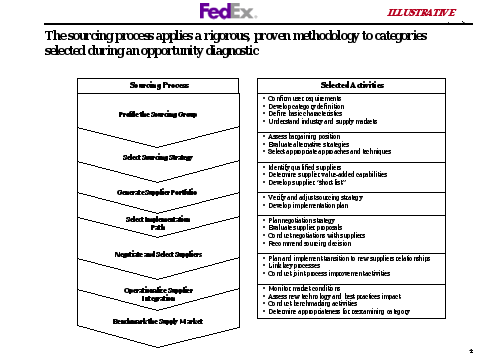
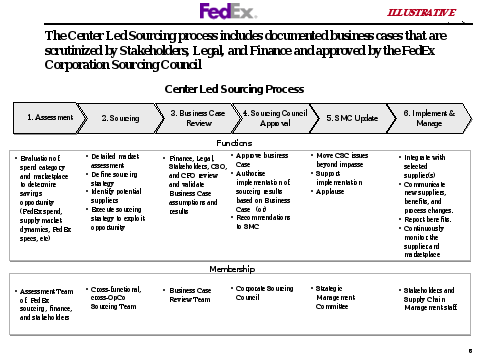
Two aspects of how this is done are important: first, a central sourcing group leads company-by-company specific sourcing initiatives. This is a team of sourcing analysts who lead these sourcing initiatives, and once they get through the process – this hands off from the sourcing advisor to a supply chain associate. These associates are spend-category associated (e.g. aircraft components, IT contracts, etc.) Their role is to take the arrangement with the supplier and ensure that it is implemented and see that it goes on within that marketplace. They are responsible for completing the scorecard with the supplier to ensure that it is completed thoroughly and accurately. This handoff occurs in Step 6 during integration.
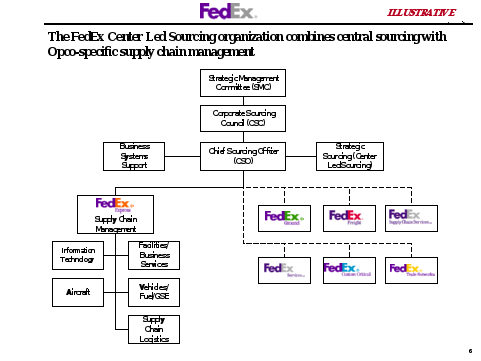
There is also a set of reviews that takes place within the sourcing process. When the team arrives at the fifth stage, one of the requirements is that they define the business case for the strategy. The team will summarize the work done in the initiative – business case goes into an extensive review. Initially, it goes to finance and legal – and validate assertions of savings, working with finance to ensure that savings are valid, with legal chiming in to ascertain that the assumptions used are acceptable. If the strategy is approved, then it proceeds to the final step, which is a review by a corporate sourcing council, consisting of high level execs from each of the divisions (COO, CFO from each business unit) – chaired by Chief Sourcing Officer. The council will review and/or reject the strategy for additional work, or approve it. If they approve, the council has an obligation to help the sourcing team implement it. They have some strong advocates to help with the implementation and ensure compliance with the terms of the agreements.
Dollar thresholds on deals that go to the sourcing council tend to be larger dollar items, or also occur when there is an impact based on the nature of spend, or level of impact on the brand image or other areas. Fuels, contract trucking (more than $10 million range) goes to the Sourcing Council. Things like a change in the nature of the supplier for FedEx boxes involving a specification change may not necessarily provide a big cost impact ($2M cost savings) but may go before the council for other reasons (to ensure it doesn’t affect other things such as market image or customer preferences). This is a largely a judgment call on the part of the Chief Sourcing Officer (Edith Kelly-Green).
FedEx does not have any Service Level Agreements in place. They have informal agreements – each of the SC groups has a director, matrixed to the primary user vice president. Facilities director is matrixed with the VP of Properties and Facilities – dotted line reporting relationship.
Supplier Scorecard
For the scorecard, FedEx has employed a generic scorecard that pertains to most of the supply relationships – they have the capability to add some unique metrics (see Appendix). The SCM group determines the threshold limits for the scorecard – but most items are NOT part of the contract. Instead, the scorecard is viewed as a way to manage the relationship, and award future business. An SCM associate will manage the performance assessment for a given supplier, and convert it into a score of 1 through 5 based on available data and input from user groups.
The idea behind the scorecard was to adopt a methodology that could be applied to compare “apples to apples” across the supply base. Associates tasked with managing the supplier are given the authority regarding where to draw the lines – relating percentage weights to different elements of the scorecard, and converting it to a 1 through 5 metric. The user requirements are incorporated into the contract through the statement of work. Factors that may or may not be included in a specific scorecard may include the following: overall strategy, resources, customer service responsibility, gratis service, number of complaints, post sales support, knowledge of Fedex, of product, upgrades, return time on warranty, bad from stock items (don’t meet quality), certification, cost trends, discrepancy rate, financial stability, mean time between failures, on-time delivery, delivery cycle time, cycle time improvement, their use of diverse suppliers, frequency of value of cost reductions, etc. These items are tied into the scorecard, with SCM associate responsible for converting raw data and input from users into a score based on the supplier’s performance associated with that contract.
The scorecard is tied to certain business rules. If the score on a scorecard becomes very low, FedEx has established different stratifications for the scorecard. If they fall below 350 on the scorecard, then the team will seriously re-evaluate their supply strategy in that market. This occurs particularly at the end of certain agreements. There are no specific criteria on guidelines, other than monitoring the scorecard and re-evaluating it on a periodic basis as necessary. The decision tends to come up on a three-year cycle, which is when most commodity groups are re-evaluated by a sourcing team. Each category has a sourcing evaluation approximately every three years, with most contracts lasting three years with an option for a three-year extension. This can vary; for example, on PC’s Fedex will re-visit the strategy much more frequently, because the dynamics of that market change much more frequently. The nature of what PC purchases may change over the course of a single year!
Supplier management is based on the SCM teams and individuals that have been established for each role. For each supplier and contract, there is an individual assigned responsibility for managing that relationship. There is rarely just one supplier – but often there is only one FedEx associate responsible for all ground support, janitorial contracts, etc. Their job is a mixture of strategic and tactical elements. For example, an associate may be responsible for catalog updates into Ariba, but also responsible for updating pricing changes. This poses a challenge to the organization: should individuals focus on the day in- day out functioning of the contract? Do they get involved in strategy-level work? How do they get involved in strategic-level issues? Associates are responsible for keeping track of what is happening in that market – so they may re-initiate a negotiation with that company, and re-visit what is happening and how that contract is set up. They are responsible for business process issues – if they have a unique element with that supplier, they may be responsible. They get into specification management as well. This may not involve a lot of high-level strategic work, but may require a good deal of coordination work between the supplier and the engineering group. The challenge of how to skill/deskill associates in this area remains problematic.
Business Rules: Controlling Maverick Spend through EProcurementThere are several different avenues regarding how purchasing occurs across FedEx. From a services perspective, there may be several different purchase methods. For a product purchase, there are currently three different methods of buying that prevail across all of the operating companies.
1. The most simple is a convenience purchase – an individual goes into a local store and buys something on their badge, takes the invoice back to their manager, and sent in for a repayment. There is not a lot of control, and the manager MUST give approval prior to purchase.
2. The next area (preferred) is the Ariba buyer system. This is set up so that users have an online catalog for contracts that are in place – several thousand office supplies are established on the catalog. Requisitioners can find they want, and once submitted, it is bounced against a purchase approval policy.
For example, if a FedEx associate needs a PC in their area, they will select a PC online, and requisition it. Depending on the threshold, they may need a supervisor’s authorization, and may need a higher level as well. If the spend goes into capital range, there are another set of approval rules to ensure that people who approve capital purchases sign off. The process also draws on the business rules from the IT group, which may be contradictory in some cases. Business rules can be enforced within the Ariba Buyer system depending on the category of spend taking place.
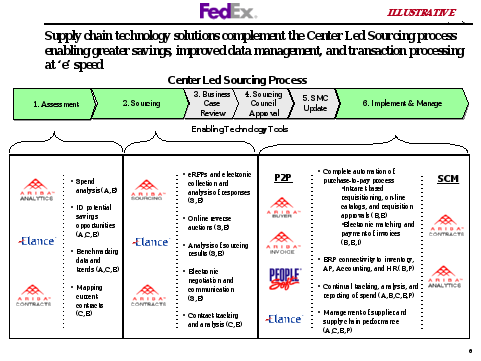
The value of this approach is that if FedEx supply management establishes a change on the control levels, it is easy to do. For example, if the CEO mandates a spending freeze (i.e. “No PC’s without VP level approval”), SCM can change the business rules on the system. (SCM does not handle travel authorization, although it has that capability. FedEx is tied in with airline agreements, so the nature of travel agreements are based on a different set of contracts.) FedEx also has another information system for temp labor, contract programmers (ELAMS). The Elams system allows online requisition for contract programmers or temp labor person based on contracts that are in place – FedEx control the rate and type of individual sent out by the supplier, and can approve the invoices online. They have issues with a temp labor contract – Clerk1 or Clark2 at a higher rate – and can ensure that if they request a Clerk 2, once they send the individual out, they can come back and tell them that they are only going to pay at a certain rate and for certain hours based on performance. This enables users to control the type of person that they actually pay for (in the past, this wouldn’t catch this until much later in the process).
All of FedEx’s spending is indirect – due to the nature of their business. A lot of their focus is on indirect materials. However, in MRO and facility parts, they struggle in terms of controlling spend in this area. Depending on product area, they have a greater or lesser ability to control maverick spend. The information they have about spending or indirect items tends to be something that is based on how much they know about the company they are purchasing from, and the length of our contract with them. They have a consolidated contract with paper, so they have good data on this spend. On MRO, they have only done our first set of national contracts, it has been out of control for us, it is difficult to get a handle on our baseline spend. They need to do more in terms of understanding this, by linking into internal accounting codes and understand what is represented by that spend.
FedEx will often do an RFI before they initiate the sourcing process. One of the first things they will do is get a handle on our accounts payable information, who are the largest suppliers, and please give us your sales to FedEx with information on line items. They are doing that with MRO, and have contracts established with MRO contracts. If it goes through Ariba, they have great information on that.
Areas where they have had the most problems are with convenience purchases (Joe Mechanic buys it over the counter at the hardware store). To control this, FedEx is now going to a monthly electronic report by purchase by avenue. If Grainger gets 600 orders from Ariba, 100 from invoices, they have a purchase summary that shows all of them. (Convenience means that the individual has an account with that store, and it goes on their account. FedEx does have a p-card that has not been extensively implemented – their internal controls group still has a lot of issues – even though they have convenience purchase problems.
Convenience purchases are still not well controlled. Because of the diversity and geographic dispersity of FedEx locations, it is still the most popular and easiest way of buying things. This has been a problem within the operations side of the business, who insist that the sheer simplicity of the process is a good reason for them to continue with the status quo. Convenience purchases has, however, become a number that has grown and caught the attention of senior management. The individual transactions are low, but many, many transactions, particularly in the MRO area, have grown to epidemic proportions. The total convenience spend is about 5 to 10 percent of all purchases, but 25-30% of all total number of transactions.
Guidelines for Controlling Maverick Spend
Although FedEx has not yet established a defined spend limit for all categories, certain category limits have been deployed. In office supplies, 60% compliance was the initial number, with a target of 80% first year, (achieved 78% compliance in 2002). This was a concerted effort to go after businesses that were not complying.
One SCM associate noted that “If our corporate program is at Corporate Express, it is easy to see when the spend is going to Office Depot. Getting support from business people was key in reducing maverick spend. It started off with having SCM people responsible for that area make some calls to purchasers that were using different suppliers. Depending on the nature of their response, different actions would follow. In many cases, the problem may have arisen due to a training issue, as people didn’t know how to use Ariba. In other cases, people had a competitive purchase, and didn’t wan’t to go through Ariba to purchase those items.”
Continuing, this associate commented that “The approach to influence business units through the Sourcing Council is less of an autocratic approach, but has been moving more to a mandate approach. In the past this has been done on a product by product area basis, but the level of maturity of the program we have had in place is increasing. PC’s have been on Ariba for some time, so there hasn’t been a lot of volatility with respect to who they buy from. It has been taken to a mandate level, whereby accounts payable can actually agree NOT to pay the invoice. That mandate becomes something that affects the supplier – so they must take the risk when they send something to supply management for payment. If they have an agreement with Dell, and someone buys from IBM, they are in trouble. That individual may be responsible for paying this with their own personal funds! (This has been announced, but not yet deployed!)
Different mandates have gone out with different people. How do you determine if something is worth addressing at all, or worth putting a strategy around? There is a dollar criteria – is it worth putting a resource on this initiative? In presenting the sourcing process, there are different levels on how extensive the process should be. If FedEx has large spend in a particular area, they will put more resources on doing an in-depth market assessment. For something that turns out to be a $2M per year spend – the payback on it may not be worth the resources required to do it. So it becomes a mini-sourcing initiative done by the Supply Chain group.
System tools can really help in this area. We need to ensure that a solid business case is put together before presenting to the Sourcing Council. We can also ensure compliance on smaller purchases through Ariba Buyer, which is the avenue for receipts. Users must follow-through on receiving of goods at many different geographic locations worldwide; yet Ariba Buyer can ensure compliance. When an order is received, users have an obligation to enter it into the system, which generates an acknowledgement and an invoice matching on the system. If an individual does not receive it, Ariba will develop email reminders that will escalate eventually to senior management.
Moving Forward
Most of the sourcing dashboards to measure performance going forward are primarily cost-focused based metrics. The group tracks the results from sourcing initiatives: cost savings, performance relative to market pricing (fuels relative to market pricing), monitoring at an individual, director, and CSO savings, including diverse supplier development, savings amount, and ROI based on staff and budget. These results are compared in terms of generating savings from one group relative to other directors. Another metric is sourcing timeframes – how long is it taking to implement the sourcing initiatives.
The associate concluded: “One of the biggest challenges in the Center-Led Initiative is: How to get people involved? FedEx had an extensive communications campaign where the strategy is communicated to people, including the long-term vision on where FedEx SCM is headed in the longer term. Within the original FedEx organization, there were not dramatic changes in how things were being done. However, for each of the new operating companies acquired, we are still going through a transition period in which we are allowing people to continue doing business through localized contracts. However, this is changing, as we are slowly moving towards a homogeneous approach from an operating standpoint. Many of the newly acquired operating companies have not done this type of communication, training in core supply chain skills, and other elements. Most of these people are totally unfamiliar with the seven-step process. Making this change is probably going to be our biggest challenge in the next five years.”
Prepared by Robert B. Handfield, North Carolina State University
Appendix: Supplier Scorecard
|
|
Supplier Scorecard
| |
| |
| Company A | ||
| Total Score: 491 (Performance Level: Platinum) |
Click here for a printer-friendly version of this card.
|
| ||||||||||||||||||||||||||||||||
| Measurement | Theyight | Score | Theyighted |
|
| |||
| Add-ons | 15 | ||
| Price Competitiveness | 30 | ||
| Average Score for Strategy | 5.0 |
| |
|
| |||
| Customer Service Responsiveness | 20 | ||
| Flexibility | 10 | ||
| Gratis Service (no incremental costs) | 10 | ||
| Number of Customer / Quality Complaints | 30 | ||
| Post Sales Support | 20 | ||
| Sales Person Knowledge of FedEx | 10 | ||
| Sales Person Product Knowledge | 10 | ||
| Technology Upgrades / Enhancements | 30 | ||
| Turn Time on Warranty Claims | 10 | ||
| Average Score for Resources | 5.0 |
| |
|
| |||
| Bad From Stock | 25 | ||
| Certification | 12 | ||
| Cost Trends | 25 | ||
| Discrepancy Rate | 15 | ||
| Financial Stability | 15 | ||
| MTBF | 20 | ||
| No. of Warranty Claims | 25 | ||
| On-Time Delivery Performance | 25 | ||
| Average Score for Processes | 4.9 |
| |
|
| |||
| Cycle Time Improvement | 10 | ||
| DSD - Direct Reporting | na | ||
| DSD - Indirect / Tier Reporting | 10 | ||
| DSD - Use of Local Suppliers | na | ||
| FedEx Cost of Quality (or benefit) | 24 | ||
| Frequency / Value of Cost Reduction Ideas | 30 | ||
| Supplier Savings Sharing | 25 | ||
| Average Score for Optimization | 4.8 |
| |
|
| |||
| Operational Compatibility / Coverage / Accessibility | 10 | ||
| Average Score for Globalization | 5.0 |
| |
|
| |||
| Offered new product-XXXXX caster- for testing | 25 | ||
| Average Score for Other/Supplier Specific | 5.0 |
| |
|
| |||
| TOTAL SCORE | 100 |
| 491 |
| Scorecard Comments |
| XXXXX caster offered for total cost reduction. Provides reports on timely basis. Sent engineer to Salt Lake City to research problem. Reps Visited Memphis. Spend June - Oct. $934,454. XXXXXX receives many small orders from the field through Ariba. XXXXX, MI plant received ISO 9001/2000 certification. One invoice duplicated and paid, but may have been FedEx problem. Diverse spend $6672. Total spend June -October $934,454. GSE requests link from Ariba to XXXXXX catalog, and ANSI X12 version of EDI. |
| Performance Levels | |||||
| Level | Platinum | Gold | Silver | Bronze | Unacceptable |
| Score | 450 - 500 | 400 - 449 | 350 - 399 | 300 - 349 | 0 - 299 |
|
| |||||
G U I D E L I N E S A N D E T H I C S F O R B E N C H M A R K E R S
I N T E R N AT I O N A L B E N C H M A R K I N G C L E A R I N G H O U S E
1 This case was developed by Robert Handfield of NC State University based on interviews with Federal Express associates, working with Brenda Liker and Jaymie Mitchell in developing best practices in sourcing for the Bank of America.




